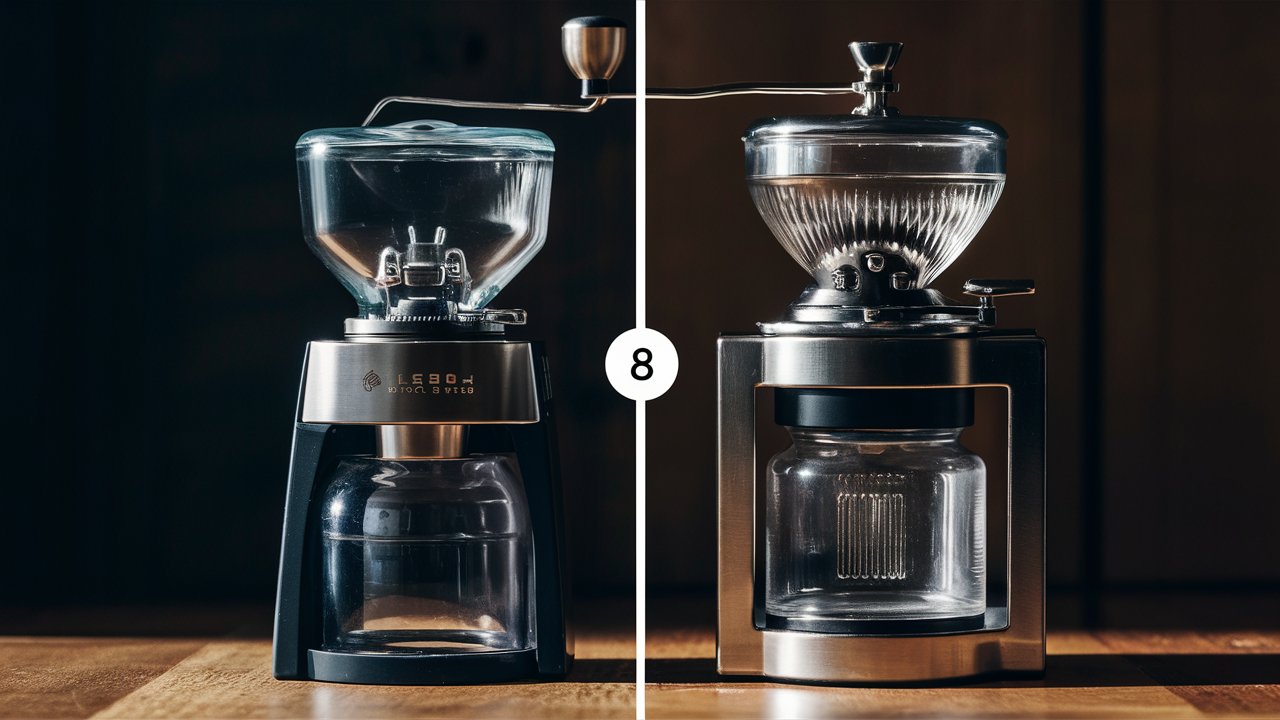
Crafting the perfect cup of coffee is an art, and the type of coffee grinder you use is a pivotal element in this craft. Among the various options available, burr grinders and blade grinders stand out as the most common. Each grinder type has unique features, benefits, and drawbacks. For any coffee aficionado striving for the best brew, understanding these distinctions is crucial. Let’s dive into the mechanics and impacts on coffee flavor and texture, comparing burr and blade coffee grinders in detail.
Understanding Blade Coffee Grinders
Blade coffee grinders are often the go-to for novices or those mindful of their budget. But what makes these grinders distinct?
How Blade Grinders Work
Blade grinders function with simplicity: a flat, spinning blade chops the coffee beans into smaller fragments. The blade spins rapidly, shattering the beans with brute force. The grind’s fineness depends on how long you let the blades whirl.
Advantages of Blade Grinders
- Affordability: Typically more economical than burr grinders, blade grinders are perfect for beginners or those hesitant to make a hefty investment.
- Simplicity: User-friendly and requiring minimal upkeep, these grinders are easy to manage.
- Compact Size: Generally small and portable, blade grinders are ideal for cramped kitchens or travel.
Disadvantages of Blade Grinders
- Inconsistent Grind: A major downside is the irregular grind size, affecting coffee flavor and extraction.
- Heat Generation: High-speed blades generate heat, potentially altering the coffee’s flavor by overheating the beans.
- Limited Control: Achieving a precise grind size is challenging due to the lack of adjustable settings.
Exploring Burr Coffee Grinders
Burr coffee grinders are the preference of many coffee enthusiasts due to their ability to produce a consistent grind. Let’s explore what sets them apart.
How Burr Grinders Work
Burr grinders crush coffee beans between two abrasive surfaces, or burrs. The gap between these burrs can be adjusted to alter the grind size. Burr grinders are available in two main types: flat burr grinders and conical burr grinders.
Advantages of Burr Grinders
- Consistent Grind Size: Burr grinders offer uniform grind size, essential for even extraction and optimal flavor.
- Adjustable Grind Settings: A range of settings allows fine-tuning of grind size for various brewing methods, from espresso to French press.
- Durability: Often sturdier than blade grinders, high-quality burr grinders are built to last.
Disadvantages of Burr Grinders
- Higher Cost: Generally pricier than blade grinders, which might deter some coffee drinkers.
- Size and Weight: Larger and heavier, these grinders require more kitchen space.
- Maintenance: Burr grinders need regular cleaning to maintain performance.
Flat Burr Grinders vs. Conical Burr Grinders
Within the burr grinder category, flat burr grinders and conical burr grinders have distinct characteristics.
Flat Burr Grinders
Flat burr grinders use two parallel rings to grind the beans with precision and consistency.
- Precision: Excellent for producing uniform grind sizes, especially for espresso.
- Heat: Can generate more heat due to the flat burrs, potentially affecting flavor with excessive use.
- Cost: Typically more expensive because of their precision capabilities.
Conical Burr Grinders
Conical burr grinders feature a cone-shaped center burr grinding against a circular outer burr.
- Heat Management: Generate less heat compared to flat burr grinders, preserving coffee flavor.
- Ease of Cleaning: Their design often makes them easier to clean.
- Versatility: Suitable for various brewing methods, offering flexibility.
Impact on Coffee Flavor and Texture
Your choice of grinder significantly affects the coffee’s flavor and texture. Let’s explore how.
Flavor Extraction
- Blade Grinders: Inconsistent grind size leads to uneven extraction. Some particles may be over-extracted, causing bitterness, while others are under-extracted, resulting in sourness.
- Burr Grinders: Uniform grind size ensures even extraction, typically resulting in a balanced, full-bodied flavor.
Texture and Mouthfeel
- Blade Grinders: Variability in grind size can affect texture, with some particles too coarse and others too fine.
- Burr Grinders: Consistent grind size provides a smoother, more pleasant mouthfeel.
Which Grinder Should You Choose?
Choosing between a burr and blade grinder depends on your coffee preferences, budget, and desire for consistency and control in your brewing process.
For Beginners and Budget-Conscious Drinkers
If you’re new to home coffee grinding or seeking an economical option, a blade grinder might suffice. It allows you to experiment without a significant investment.
For Coffee Enthusiasts and Perfectionists
For those serious about their coffee and seeking the best possible flavor, investing in a burr grinder is worthwhile. The consistency and control offered by burr grinders can elevate your coffee experience.
Conclusion
In summary, while both burr and blade coffee grinders have their place in coffee brewing, burr grinders generally provide superior consistency and flavor quality. Blade grinders, however, are more accessible and user-friendly for beginners. Understanding the differences between these two grinder types can help you make an informed choice, enhancing your daily coffee ritual.



